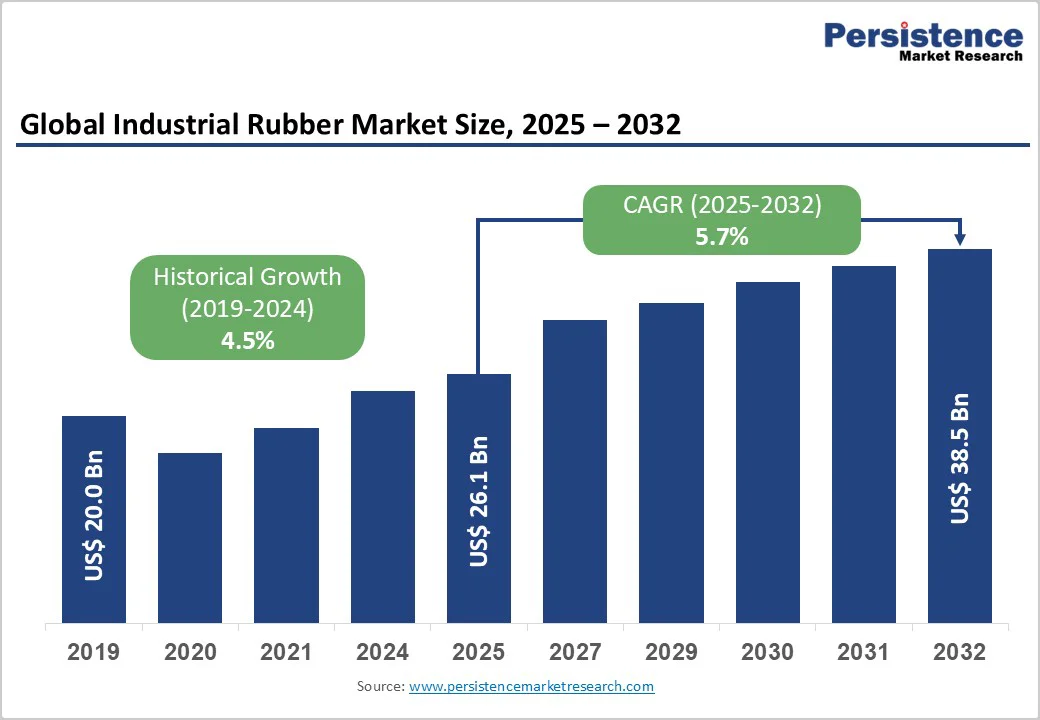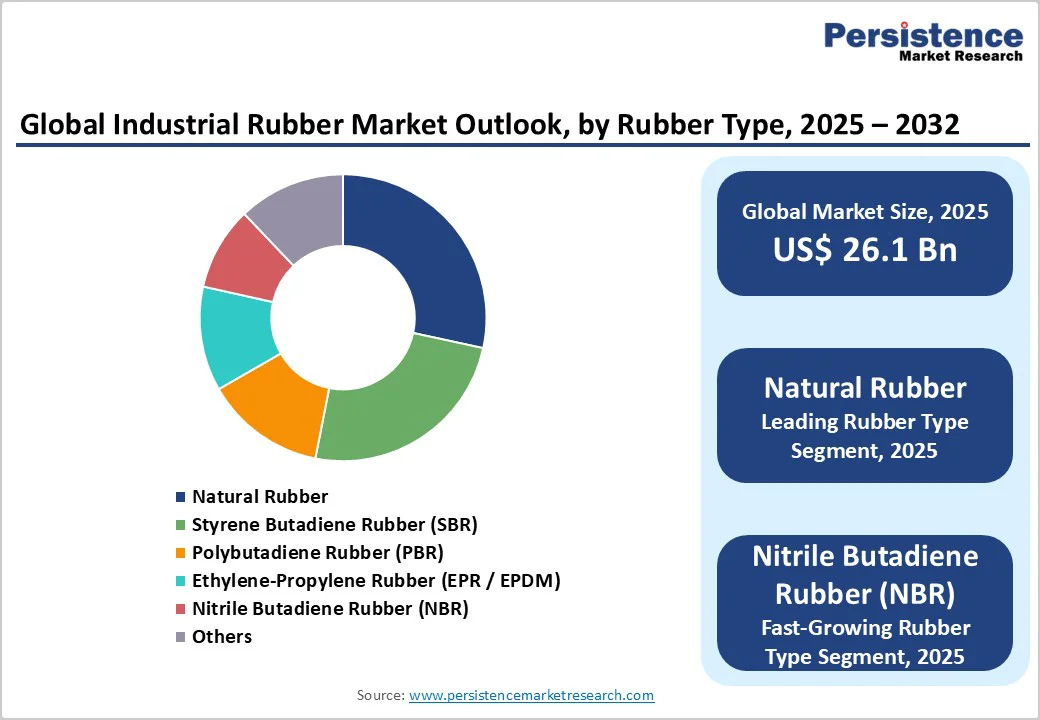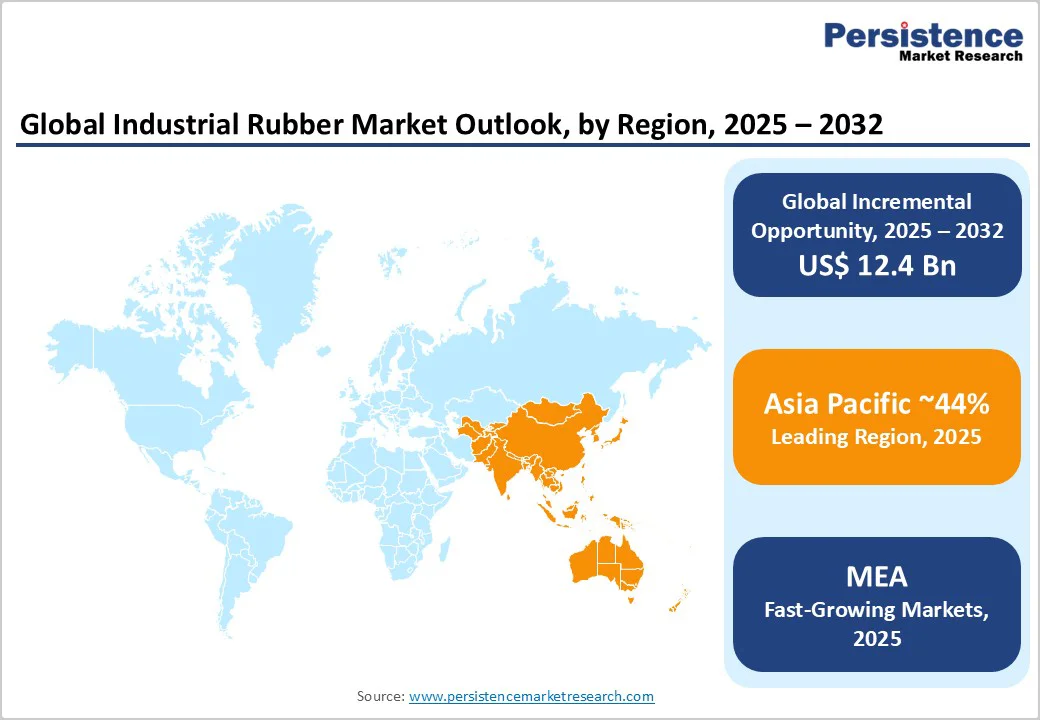ID: PMRREP14041| 175 Pages | 26 Nov 2025 | Format: PDF, Excel, PPT* | Chemicals and Materials

The global industrial rubber market size is valued at US$ 26.1 billion in 2025 and is projected to reach US$ 38.5 billion, growing at a CAGR of 5.71% between 2025 and 2032.
The global automotive production market is accelerated, particularly electric vehicle with the need for specialized rubber components, coupled with infrastructure development initiatives across emerging economies and energy sector modernization has encouraged the market growth.
The automotive industry's dominance, combined with growing demand for specialized synthetic rubbers, including NBR and EPDM for industrial applications, creates sustained momentum. Technological advancements in polymer modification, green tire formulations, and sustainable rubber production methodologies further reinforce positive growth trajectories across developed and developing markets.
| Key Insights | Details |
|---|---|
| Industrial Rubber Market Size (2025E) | US$ 26.1 billion |
| Market Value Forecast (2032F) | US$ 38.5 billion |
| Projected Growth CAGR (2025 - 2032) | 5.7% |
| Historical Market Growth (2019 - 2024) | 4.5% |

The automotive sector represents the largest consumer of industrial rubber, accounting for approximately 38% of global demand, with consumption spanning tires, seals, gaskets, hoses, vibration-damping components, and weatherstripping applications. Global vehicle production is projected to exceed 95 million units annually by 2025, with electric vehicle (EV) sales experiencing exponential growth.
India's automotive industry demonstrated 12% growth in 2024 with annual sales exceeding 25 million vehicles, as announced at the Bharat Mobility Global Expo 2025. The transition to electric mobility creates differentiated rubber requirements, as EVs demand superior noise-vibration-harshness (NVH) reduction due to the absence of engine noise masking.
The global automotive rubber molded components market, encompassing gaskets, hoses, and seals, demonstrates substantial expansion potential, with manufacturers like Freudenberg Sealing Technologies developing next-generation rubber gaskets resistant to bio-based fuels and high-temperature environments (November 2024).
This automotive demand multiplier effect extends across the entire value chain, creating sustained procurement commitments from OEMs and tier-1 suppliers globally.
Industrial rubber manufacturing faces persistent challenges from fluctuating raw material costs, particularly natural rubber, synthetic rubber precursors (butadiene, styrene), and specialty additives. Natural rubber prices demonstrate significant volatility due to geographic concentration of production in Southeast Asia, climatic factors affecting yields, and geopolitical considerations.
The natural rubber market experiences periodic supply constraints due to deforestation concerns, labor shortages, and disease outbreaks affecting rubber plantations. Synthetic rubber production depends heavily on petroleum-based feedstocks, creating direct linkages between crude oil price fluctuations and production costs.
Styrene-butadiene rubber (SBR), representing 40.2% of the synthetic rubber market share, experiences cost pressures from petrochemical price volatility and refinery capacity constraints. Supply chain disruptions demonstrated during the COVID-19 pandemic revealed vulnerabilities in global rubber distribution networks, with extended lead times and logistics bottlenecks constraining manufacturer flexibility and margin stability.
The electric vehicle revolution creates substantial opportunities for specialized synthetic rubber formulations optimized for EV-specific requirements, including enhanced NVH performance, thermal management, and lightweight characteristics. The global automotive rubber parts market is projected to grow at a significant pace, with EVs representing the primary growth driver.
EV applications require rubber components with superior heat resistance for battery pack sealing, enhanced electrical insulation properties, and reduced weight to maximize range efficiency. Continental AG's 2024 launch of dandelion-derived rubber (Taraxagum) demonstrates innovation potential in sustainable tire materials, while smart bushing technologies integrating sensors for real-time performance monitoring represent emerging product categories.
Manufacturers developing specialized EPDM blends, silicone rubber formulations, and high-consistency rubber (HCR) materials for EV cooling systems can capture premium market segments willing to pay technology premiums for performance advantages.
Natural rubber commands 28% market share and remains the preferred material for applications requiring superior elasticity, tear resistance, and dynamic performance characteristics. The natural rubber market, valued at US$ 16.5 billion in 2022, demonstrates sustained demand across tire manufacturing, industrial goods, and specialty applications.
Natural rubber's biodegradability and renewable sourcing align with sustainability initiatives gaining prominence across automotive and consumer goods sectors. The material's exceptional mechanical properties, including high tensile strength, excellent abrasion resistance, and superior resilience, make it indispensable for high-performance tire applications, particularly in commercial vehicles and off-road equipment.
However, natural rubber faces supply constraints due to geographic concentration in Southeast Asia (Thailand, Indonesia, Malaysia, Vietnam) and climatic vulnerability affecting plantation yields. Despite synthetic alternatives, natural rubber maintains market leadership through established supply chains, proven performance histories, and cost competitiveness in bulk applications.
Nitrile Butadiene Rubber (NBR) is the fastest-growing rubber type, with a 6.3% CAGR, fueled by its applications in automotive sealing systems, oil & gas infrastructure, and industrial machinery. Its excellent oil resistance and chemical stability make NBR vital for fuel systems, hydraulic seals, O-rings, and gaskets.
The aviation sector, with a 51% annual increase in air traffic demand, further boosts NBR usage for aircraft sealing applications. Additionally, the rise of automation in industrial manufacturing increases NBR consumption for seals and hoses. Its versatility and ongoing formulation improvements enhance its heat resistance and durability, allowing NBR to capture market share from traditional rubber types.
Hoses and tubing represent the dominant product category with 28% market share , serving critical fluid transfer and conveyance functions across automotive, industrial, and construction applications. The automotive rubber hoses market demonstrates steady growth driven by vehicle production expansion and engine downsizing trends requiring high-temperature resistant synthetic rubber hoses.
Industrial manufacturing utilizes rubber hoses extensively for hydraulic systems, pneumatic applications, chemical transfer, and material handling operations. Technological advancements include high-performance vacuum tubes reducing weight by 50% (Cooper Standard), supporting automotive industry lightweighting initiatives for fuel efficiency improvement.
The product category's market leadership reflects the ubiquitous nature of fluid conveyance requirements across industries, established manufacturing capabilities, and continuous demand from replacement markets, ensuring revenue stability.
Vibration mounts and bushings represent the fastest-growing segment at 6.1% CAGR, propelled by rising NVH control requirements, precision machinery adoption, and EV growth. Advanced technologies such as Continental AG’s Active Bush system, which reduces cabin vibrations by 50%, exemplify innovation in comfort and performance optimization.
The integration of sensors and IoT connectivity in smart bushings enables predictive maintenance and enhanced vibration isolation. With increasing demand from EVs, aerospace, and industrial automation, this segment is positioned for strong and sustained growth across multiple high-performance applications.
The automotive sector dominates with a 38% share, representing the largest and most diversified end-use category for industrial rubber. The automotive rubber parts market is growing at a significant pace and encompasses tires, seals, gaskets, hoses, belts, vibration dampers, and weatherstripping applications.
Global vehicle production recovery, particularly across emerging markets, drives sustained rubber demand. India's automotive gaskets and seals market demonstrates 6.2% CAGR through 2032, supported by rising fuel-efficiency standards and increased vehicle production.
The EV transition creates specialized requirements for battery pack sealing, thermal management hoses, and enhanced NVH components, supporting premium pricing opportunities. Automotive applications account for over 70% of natural rubber consumption and approximately 60% of synthetic rubber usage, underscoring the sector's foundational importance to industrial rubber markets.
The energy sector emerges as the fastest-growing end-use market at 6.4% CAGR, encompassing both conventional and renewable power segments. Rubber components such as seals, gaskets, and flexible connectors are indispensable in oilfield drilling equipment, refineries, and gas distribution pipelines.
Materials like NBR, EPDM, and silicone rubber ensure reliability under extreme thermal, pressure, and chemical exposure conditions. Simultaneously, renewable infrastructure, spanning solar, wind, and hydroelectric systems, drives additional rubber demand for weather-resistant sealing and vibration control solutions.
The global transition toward cleaner energy creates a dual growth opportunity: continued replacement demand in oil & gas operations and expanding consumption in renewables, positioning the energy sector as a critical and fast-evolving end-use domain within the industrial rubber market.

North America demonstrates robust growth at 5.5% CAGR, characterized by technological sophistication, mature automotive sector demand, and strong regulatory frameworks driving advanced material adoption. The United States represents over 40% of North American rubber consumption, with automotive applications dominating across tires, seals, gaskets, and vibration-damping components.
The region's emphasis on electric and autonomous vehicle development creates differentiated rubber requirements, with manufacturers prioritizing performance-driven materials for NVH reduction and thermal management. Stringent environmental regulations accelerate the shift toward bio-based synthetic rubbers, recycled rubber compounds, and sustainable production methodologies.
The industrial manufacturing sector's adoption of automation and precision machinery drives demand for advanced vibration mounts and specialty rubber components.
North American competitive dynamics favor innovation and technology leadership, with established players including Goodyear, ExxonMobil, and specialized elastomer producers investing heavily in R&D capabilities. The freight rail and commercial vehicle segments generate substantial demand for durable rubber components capable of handling heavy loads and sustained operational demands.
Wabtec Corporation's focus on brake and damping system integration for locomotives exemplifies market opportunities in transportation infrastructure. The region's mature construction sector maintains steady EPDM rubber demand for roofing membranes and sealing applications, while oil & gas operations in Texas and North Dakota require specialized NBR and silicone sealing solutions for harsh operating environments.
Europe holds 24% global market share, positioning the region as a significant industrial rubber market characterized by sustainability leadership, regulatory harmonization, and advanced automotive manufacturing. Germany, France, the United Kingdom, and Spain collectively account for approximately 60% of European rubber consumption, with automotive and construction sectors driving demand.
The European Union's stringent environmental regulations mandate reduced rolling resistance for tires, VOC emission controls, and recycled content requirements, compelling manufacturers to invest in sustainable rubber technologies. Continental AG's development of dandelion-derived rubber and eco-friendly tire formulations exemplifies European innovation in sustainable materials.
The region's automotive sector recovery, coupled with electrification initiatives across major OEMs (Volkswagen, Mercedes-Benz, BMW, Stellantis), creates sustained demand for specialized rubber components. European EPDM rubber market growth is supported by construction sector applications, particularly roofing membranes and waterproofing solutions utilizing EPDM's superior weather resistance.
Regulatory harmonization through EU standards enables manufacturers to achieve economies of scale while servicing multiple national markets, supporting margin stability and technology investment capabilities. The synthetic rubber market's emphasis on polymer modification and advanced compounding techniques drives continuous product evolution.
Infrastructure investment programs and cross-border rail connectivity initiatives create incremental demand for industrial rubber components across transportation applications.
Asia Pacific dominates with 44% global market share, establishing the region as the primary growth engine for industrial rubber markets through manufacturing advantages, rapid industrialization, and massive automotive sector expansion. China, India, Japan, and ASEAN nations represent the core markets, collectively accounting for over 70% of natural rubber production and 50% of synthetic rubber demand.
China's automotive sector, producing over 25 million vehicles annually, drives massive rubber consumption across tires, components, and industrial applications. India's 12% automotive industry growth in 2024, with sales exceeding 25 million units, demonstrates explosive demand trajectories.
The region's manufacturing cost advantages, raw material proximity, and established supply chains enable competitive positioning in global markets. Infrastructure development across emerging Asian economies, including metro systems, high-speed rail, highways, and industrial parks, creates sustained demand for construction rubber applications.
The Indian gaskets and seals market, projected to grow at a 7.4% CAGR, exemplifies growth potential. Strategic localization investments by global manufacturers indicate confidence in long-term growth prospects and create competitive barriers through established customer relationships and supply chain integration.

The global industrial rubber market exhibits moderate concentration with leading players commanding approximately 40-50% combined market share. The market structure allows regional specialists and product-focused manufacturers to maintain viable positions across specialized applications and geographic markets.
Market entry barriers include established OEM relationships, significant R&D investment requirements, technical certification complexities, and scale economies in production. Leading players leverage diversified product portfolios spanning natural and synthetic rubbers, global manufacturing networks, and vertical integration capabilities to sustain competitive advantages.
Competitive positioning reflects technology leadership, sustainability credentials, and customer relationship depth rather than price competition alone, supporting relatively stable margin profiles. The synthetic rubber market's fragmentation with numerous regional producers creates opportunities for consolidation and market share gains through strategic acquisitions.
The global Industrial Rubber Market size is valued at US$ 26.1 Billion in 2025 and is projected to reach US$ 38.5 Billion by 2032.
The Industrial Rubber Market is primarily driven by global automotive production growth along with electric vehicle proliferation requiring specialized NVH components, infrastructure development across emerging economies, energy sector expansion with oil & gas seals, technological advancements in smart rubber components, and regulatory mandates for sustainable materials, compelling adoption of bio-based rubber formulations and recycled content.
The Industrial Rubber Market is projected to grow at a 5.71% CAGR between 2025 - 2032.
Major market opportunities include electric vehicle specialized rubber formulations addressing enhanced NVH requirements and thermal management, Asia Pacific manufacturing localization, smart rubber component development with IoT integration, and sustainable bio-based rubber innovations meeting regulatory requirements while commanding premium pricing across automotive and construction applications.
Leading market players include Bridgestone Corporation, Michelin SCA, Continental AG, The Goodyear Tire & Rubber Company, ARLANXEO, China Petrochemical Corporation (Sinopec), LANXESS AG, and other players, collectively commanding significant market share through technology leadership, diversified product portfolios spanning natural and synthetic rubbers worldwide.
| Report Attribute | Details |
|---|---|
| Historical Data/Actuals | 2019 - 2024 |
| Forecast Period | 2025 - 2032 |
| Market Analysis Units | Value: US$ Bn/Mn, Volume: As applicable |
| Geographical Coverage |
|
| Segmental Coverage |
|
| Competitive Analysis |
|
| Report Highlights |
|
By Product Type
By Application
By Vehicle Type
By Region
Delivery Timelines
For more information on this report and its delivery timelines please get in touch with our sales team.
About Author